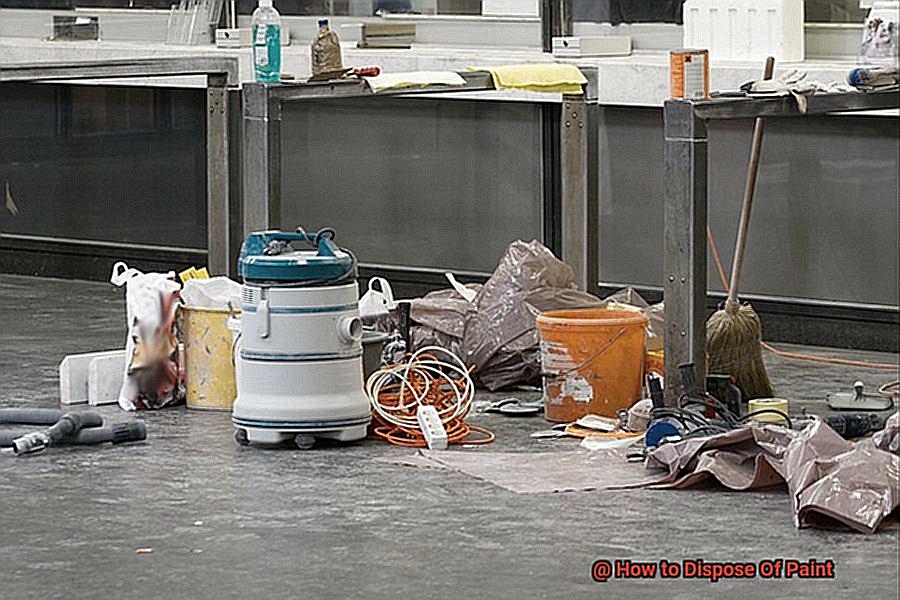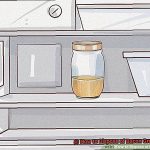Painting is often the go-to solution in home improvement projects.
But what do you do with leftover paint? Is it safe to throw it away? Not so fast. Improperly disposing of paint can be harmful to both the environment and your health.
That’s why it’s important to know how to dispose of paint correctly.
This blog post will explain how to safely get rid of latex or oil-based paints, from recycling and reusing them, to disposing of them at a hazardous waste facility.
We’ll also provide tips on minimizing waste and advice on storing leftover paint for future use.
By following these steps, you can help protect our climate while still getting rid of any unwanted paint safely and responsibly.
Let’s begin.
What Are the Different Types of Paint?
Contents
- 1 What Are the Different Types of Paint?
- 2 Can You Pour Paint Down the Drain?
- 3 How to Dispose Of Paint Properly?
- 4 What Do You Do With Paint You Want to Throw Away?
- 5 How Do You Harden Paint for Disposal?
- 6 How Do You Dispose of Paint and Chemicals Safely?
- 7 What Are Some Tips For Cleaning Up After Painting?
- 8 Conclusion
Paint is the ultimate tool for transforming any space. Whether it’s a room in your home or an outdoor surface, you can find the perfect color to bring your vision to life.
But before you pick up a brush, let’s explore the two main categories of paint and their unique subtypes.
Water-based paint, like latex and acrylic latex, is great for interior walls and trim because it dries quickly and has a nice finish that will really make your room shine.
On the other hand, oil-based paints are best suited for outdoor projects since they can withstand harsh weather conditions.
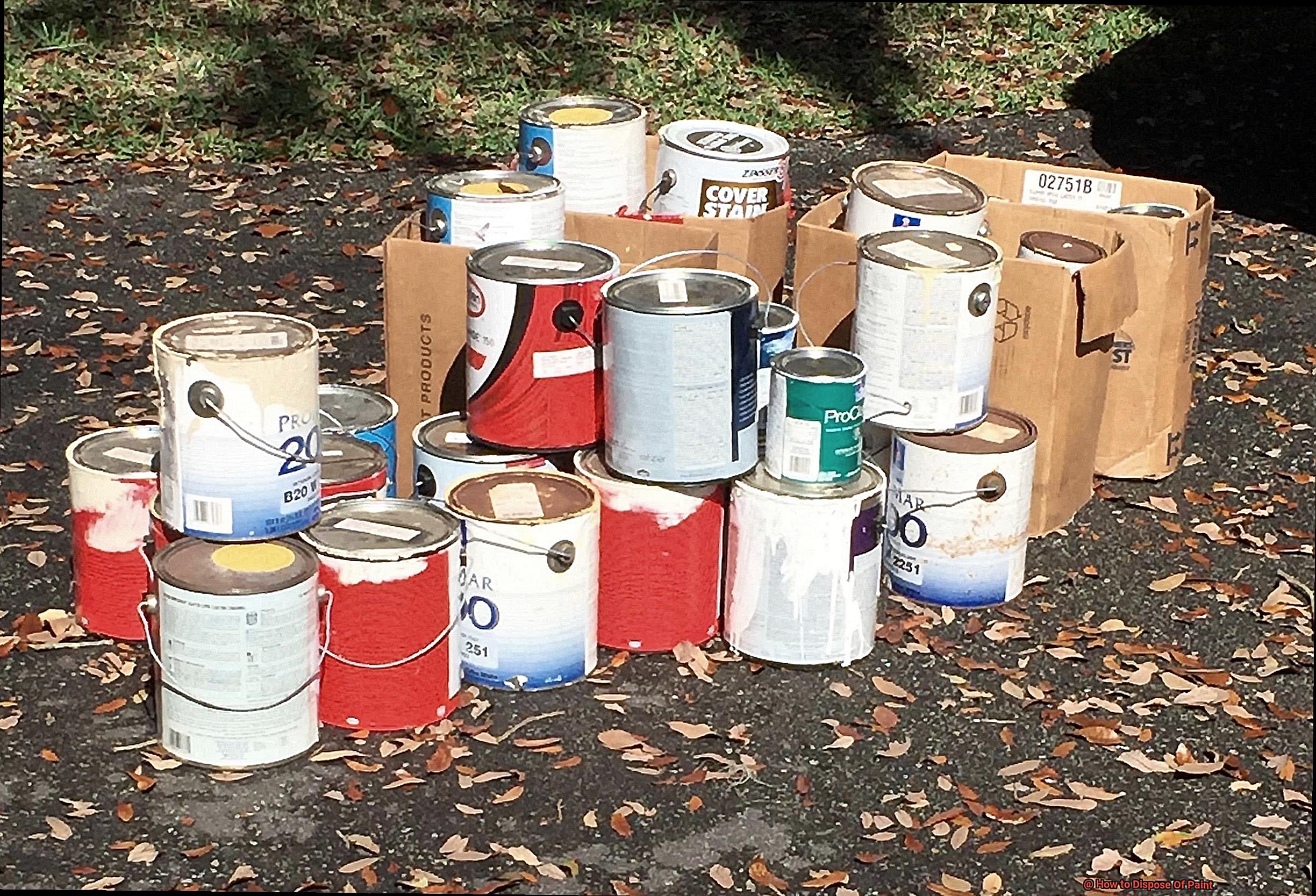
These paints are made with alkyd or linseed oil, but they tend to take longer to dry than other types of paint.
If you’re looking for something more unique, try specialty paints such as epoxy, enamel, lacquer, and polyurethane.
These finishes can be used for specific tasks like refinishing furniture or creating a glossy look on the floor.
While not as common as the two main categories of paint mentioned above, these specialty paints can add that extra touch of personality to your project.
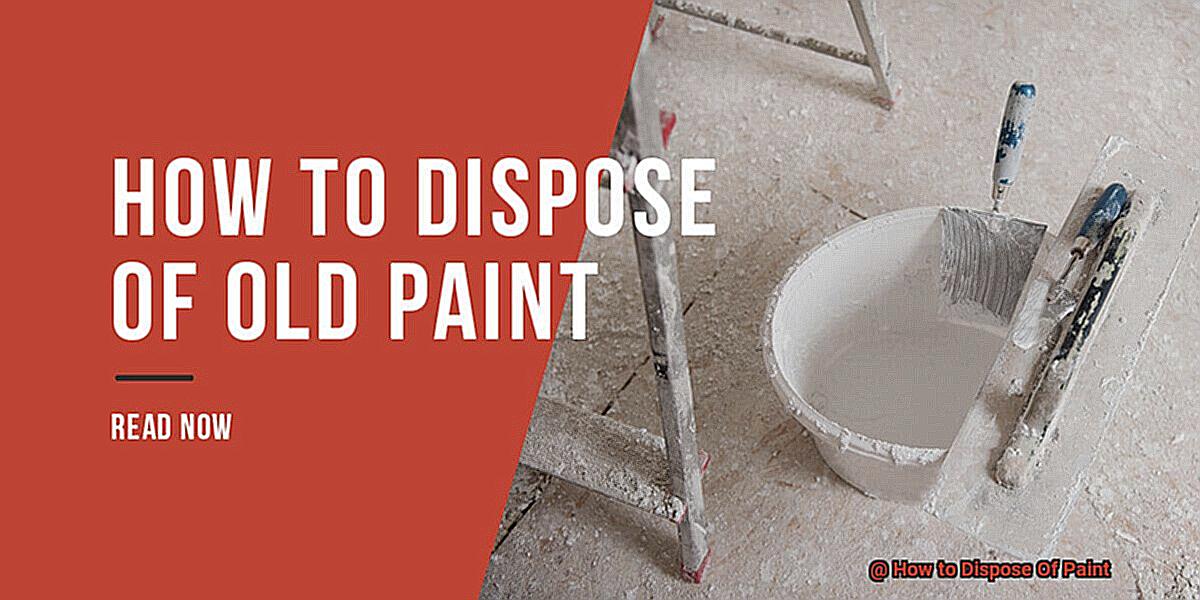
No matter what kind of paint you choose for your project, make sure it meets all your needs and delivers the results you expect.
Can You Pour Paint Down the Drain?
The answer is a resounding no.
Pouring paint down the drain will not only clog up your pipes, but it can also be hazardous to our environment.
Paint contains toxic materials that can cause serious damage to our ecosystems if released into the wild.
The best way to dispose of paint is by taking it to a hazardous waste facility or collection site.
If you don’t have access to one of these, make sure you use a biodegradable paint thinner or detergent when pouring paint down the drain.
This will help break down the paint and prevent your pipes from getting clogged up.
Before you dump any paint, make sure you check with your local municipality about any regulations regarding disposal of paint in your area.
How to Dispose Of Paint Properly?
It is essential to properly dispose of paint in order to protect both our health and the environment.
Paints contain volatile organic compounds, which can be hazardous if not treated with care.
So, how can we get rid of our old paint quickly and safely?
First and foremost, never pour paint down the drain. Doing so will contaminate our water sources and cause severe damage to the environment.
Instead, harden your paint before throwing it away.
To do this, mix kitty litter or sawdust into the paint until it thickens and then put it in a sealed container with other non-hazardous items such as cardboard or paper towels.
Remember to label any cans you use for painting so that they are not mistaken for food or other items when they are disposed of at a hazardous waste facility or recycling center.
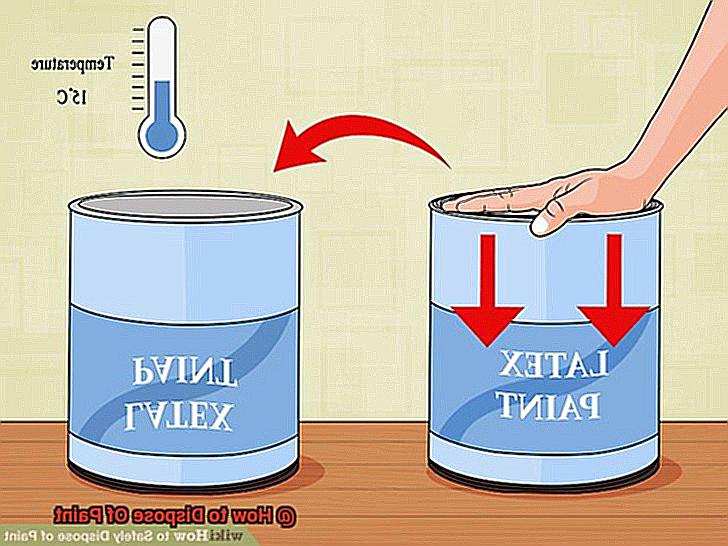
If you have a large amount of paint that needs to be disposed of, contact your local government for advice on how to do this correctly.
Alternatively, if you have leftover paint that cannot be used, think about giving it away or donating it to charity.
At the end of the day, proper disposal of paint is critical for both personal safety and environmental protection.
We can ensure that our old paints aren’t polluting our water sources or harming anyone’s health by following these tips.
What Do You Do With Paint You Want to Throw Away?
Improper disposal of paint can be damaging to the environment.
Fortunately, there are several options available for safely getting rid of unused paint.
First, consider donating your unused paint to charities such as Habitat for Humanity or similar organizations.
This is a great way to help your local community while still removing hazardous materials from landfills.
You may also be able to find a local paint store that will accept your old paint for recycling.
If neither of these options are available, please contact your local government for assistance.
They may be able to advise you on how to properly dispose of it or direct you to a hazardous waste disposal facility near you.
Getting rid of old, unwanted paint doesn’t have to be difficult – think of it as an opportunity for both you and the environment.
How Do You Harden Paint for Disposal?
With a few simple steps, you can easily harden paint for disposal.
The first option is to mix the paint with an absorbent material such as sawdust, kitty litter, or shredded paper.
This will help the liquid paint to soak up and form into a solid mass that can be safely disposed of in the trash.
Another option is to use a paint hardener product.
These products are specifically designed for this purpose and will quickly turn the paint into a solid mass that can be safely discarded.
When using a paint hardener, it’s essential to follow the instructions carefully and use the correct amount of product for the amount of paint you’re trying to harden.
It’s just like baking a cake; if you don’t measure out your ingredients correctly, you won’t get the desired result.
It’s also important to keep in mind that some paints may not be able to be hardened with a paint hardener product and will need to be disposed of as hazardous waste at a proper disposal facility.
How Do You Dispose of Paint and Chemicals Safely?
When a project is complete, it’s time to get rid of the leftover paint and chemicals.
But how can you do this safely?
The answer lies in following your local government regulations for disposal.
Contact them to find out what your options are.
In some cases, you may be able to take the materials to a hazardous waste collection center nearby.
If that’s not possible, check with local hardware stores or paint stores for other solutions.
Never pour paint or chemicals down the drain. This will cause serious environmental damage and should be avoided at all costs.
If no other option is available, hire a professional disposal service to handle the job safely and responsibly.
Disposing of paint and chemicals properly is essential for our environment, health, and wellbeing.
What Are Some Tips For Cleaning Up After Painting?
Cleaning up after painting is an essential step in the process to ensure that your home remains safe and free from any paint-related injuries.
To ensure your safety, make sure to wear protective gear like gloves, goggles, and a face mask when cleaning up.
Here are some tips for cleaning up after painting:
Wear Protective Gear
Wear protective gear such as gloves, goggles, and a face mask to prevent any contact with potentially hazardous materials and keep your clothes clean and free of paint splatters.
Clean Brushes and Rollers
Use warm, soapy water to clean brushes and rollers thoroughly.
Use an old toothbrush or wire brush for any stubborn paint spots.
Finally, rinse them with warm water until all the soap residue is gone.
Use a Paint Scraper or Putty Knife
To remove any dried paint from surfaces, use a paint scraper or putty knife to gently scrape away any hardened pieces of paint without scratching the surface of the wall or other areas where you are working.
Vacuum Up Any Dust or Debris
Painting can produce a lot of dust and rubble, so make sure you vacuum up any mess that has been created during the painting process in order to keep your house clean and free of dust particles that could damage your new painting job.
Wipe Down Surfaces with a Damp Cloth
To get rid of any remaining paint residue, use a damp cloth to wipe down surfaces before applying another coat of paint or varnish in order to ensure that no streaks or smudges are left behind on walls or furniture.
Finally, make sure that all of your painting supplies are properly stored away in an airtight container when not in use so that they don’t become contaminated with dust or dirt particles that could affect the quality of your next painting project.
Conclusion
Painting can bring your vision to life and transform any room, but it’s also essential to dispose of paint correctly.
Improper disposal of paint can be hazardous to both the environment and our health.
To safeguard our planet and its inhabitants, we must learn how to do it properly.
This article has provided an overview of how to dispose of paint responsibly, from hardening it for disposal in the garbage to transporting it to a hazardous waste facility or recycling center.
Moreover, we’ve outlined tips for minimizing waste and ways to save leftover paint for future use.
At the end of the day, protecting our climate is everyone’s responsibility.
By taking these steps, we can ensure that our water sources remain clean and safe for generations to come.
